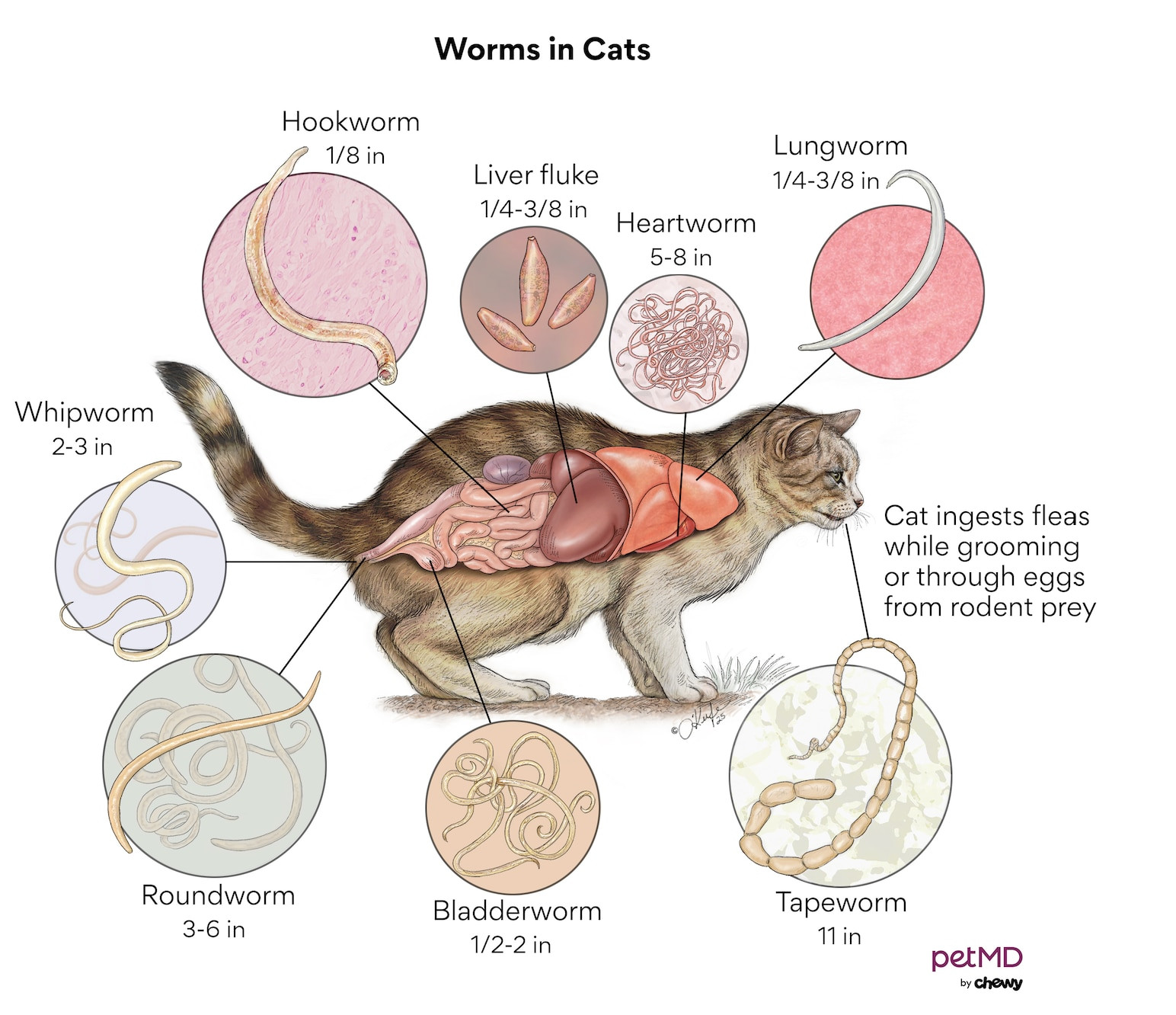Discovering worms in your cat’s stool can be unsettling. It’s important to know that intestinal worms are common parasites in both kittens and adult cats, with prevalence rates reaching as high as 45% in the US. While often not immediately life-threatening, a severe worm infestation can become a serious health issue if left untreated.
 Diagram showing different locations of worms inside a cat's body
Diagram showing different locations of worms inside a cat's body
If you suspect your feline friend has worms, promptly consult your veterinarian. A picture or a stool sample can be helpful for accurate diagnosis and treatment. Immediate veterinary attention is crucial if you observe additional symptoms like pale gums, breathing difficulties, vomiting, or loss of appetite alongside suspected worms.
Common Types of Worms in Cats
Gastrointestinal worms are the most frequently encountered type in cats. These include:
- Roundworms: These are one of the most common, often appearing like spaghetti.
- Hookworms: Smaller than roundworms, they attach to the intestinal wall and feed on blood.
- Tapeworms: Long, flat worms composed of segments that resemble grains of rice, often visible near the anus or in stool.
- Whipworms: Less common in cats than in dogs, residing in the large intestine and cecum.
Besides GI worms, other types can also affect cats:
- Heartworms: These reside in the heart and lungs and are transmitted through mosquito bites.
- Lungworms: Infect the lungs and airways, causing respiratory issues.
- Bladder worms: Found in the bladder, potentially leading to urinary tract problems.
Understanding the different types of worms can help you better recognize potential symptoms and seek appropriate veterinary care.
Recognizing the Signs: Symptoms of Worms in Cats
The symptoms of worms in cats can vary depending on the type of worm and the severity of the infestation. Here are some common signs to watch out for:
- Visible Worms: The most obvious sign is seeing worms in your cat’s feces or around their anus. Roundworms look like spaghetti, while tapeworm segments resemble rice grains.
- Vomiting: Cats may vomit worms, especially roundworms, as they can irritate the stomach lining.
- Diarrhea: Worms can disrupt the digestive system, leading to diarrhea, which may sometimes contain blood or mucus.
- Weight Loss: Despite a normal or increased appetite, a cat with worms may lose weight because the parasites are absorbing nutrients.
- Pot-bellied Appearance: Kittens with roundworm infestations can develop a swollen abdomen while being thin overall.
- Coughing: Infections with lungworms or roundworms (during their larval migration through the lungs) can cause coughing.
- Scooting: Tapeworms can cause anal irritation, leading cats to drag their rear end along the floor (“scooting”).
- Lethargy and Weakness: Severe worm infestations, particularly hookworms, can cause anemia (low red blood cell count) leading to weakness and lethargy.
- Poor Coat Condition: A dull, dry coat can be a sign of overall poor health, including worm infestations, as parasites steal essential nutrients.
- Pale Gums: Hookworms feed on blood, and a heavy infestation can cause anemia, resulting in pale gums.
- Increased Appetite: Some cats with worms may eat more than usual as their bodies try to compensate for nutrient loss.
- Decreased Appetite: Conversely, some cats may lose their appetite due to general malaise caused by the worms.
It’s important to note that some cats, especially those with mild worm infestations, may not show any obvious symptoms. This is why regular veterinary check-ups and fecal exams are crucial for early detection.
How Cats Get Worms: Understanding the Causes
Understanding how cats contract worms is essential for prevention. Common causes include:
- Nursing from an Infected Mother: Kittens are frequently infected with roundworms through their mother’s milk, as larvae can be transmitted this way.
- Ingesting Contaminated Environments: Cats can ingest worm eggs from contaminated soil, feces, or food. This can happen when grooming after walking in contaminated areas or drinking from contaminated water sources.
- Eating Infected Animals: Hunting and eating rodents, birds, or fleas that carry worm larvae or eggs is a common route of infection, particularly for tapeworms and roundworms.
- Skin Penetration: Hookworm larvae can penetrate the skin, especially through the paws, leading to infection.
- Mosquito Bites: Heartworms are transmitted exclusively through the bite of infected mosquitoes.
Keeping cats indoors significantly reduces their exposure to many of these sources of infection, especially gastrointestinal worms.
Diagnosing Worms: What to Expect at the Vet
If you suspect your cat has worms, a veterinary visit is necessary for accurate diagnosis and treatment. The diagnostic process typically involves:
- Physical Examination: Your veterinarian will perform a general physical exam, checking for signs like pale gums, pot-belly, and overall health status.
- Fecal Examination: The most common diagnostic test is a fecal examination, also known as a fecal float. You can bring a fresh stool sample from home, or your vet can collect one during the visit.
- Fecal Floatation Test: This test involves mixing a small stool sample with a special solution that causes worm eggs and larvae to float to the surface, making them visible under a microscope. This helps identify the type of worm and the severity of the infestation.
Even if you’ve seen worms in your cat’s stool, a fecal exam is still important to confirm the type of worm and rule out other types of parasites. Cats can sometimes be infected with multiple types of worms simultaneously.
Treatment Options for Cat Worms
Treatment for worms in cats is generally effective and involves deworming medications prescribed by your veterinarian.
- Deworming Medications: Roundworms, hookworms, whipworms, and tapeworms are typically treated with oral or topical deworming medications. Injectable formulations are also available in some cases.
- Prescription is Key: It is crucial to use medications prescribed by your vet, as over-the-counter dewormers may not be effective or safe for all types of worms or for your cat’s specific condition.
- Following Vet’s Instructions: Treatment duration and dosage vary depending on the type of worm and medication. Strictly adhere to your veterinarian’s instructions and schedule follow-up appointments and fecal tests to ensure the treatment is successful.
The cost of deworming varies depending on factors such as the type of worm, severity of infection, medication type and dosage, and your cat’s overall health.
Prevention is Key: Protecting Your Cat from Worms
Preventing worm infestations is always better than treating them. Effective prevention strategies include:
- Regular Deworming: Talk to your veterinarian about a regular deworming schedule, especially for kittens and outdoor cats.
- Maintain a Clean Litter Box: Scoop the litter box daily to minimize the build-up of worm eggs and prevent environmental contamination. Regularly disinfect the litter box.
- Routine Stool Testing: Even for indoor cats, fecal exams are recommended twice a year. Kittens and newly adopted cats, as well as outdoor cats, may need more frequent testing (up to four times a year).
- Year-Round Parasite Prevention: Monthly parasite preventatives, which can be topical or oral, offer broad protection against heartworms, fleas, ticks, and some intestinal worms. Discuss the best option for your cat with your vet.
- Flea Control: Fleas can transmit tapeworms, so effective flea prevention is crucial.
- Limit Outdoor Exposure: Keeping your cat indoors reduces exposure to many sources of worms.
- Regular Veterinary Wellness Visits: Annual or bi-annual wellness exams allow your vet to monitor your cat’s health, perform routine fecal exams, and recommend appropriate preventative measures.
FAQs About Worms in Cats
Will worms in cats go away on their own?
No, worm infestations in cats will not resolve without treatment. Untreated worms can thrive and live for months or even years, causing significant health problems. If you suspect worms, veterinary intervention is essential.
How do you deworm a cat at home?
There are no safe and effective home remedies for deworming cats. Garlic and apple cider vinegar, often touted as natural treatments, are not effective against worms and can even be toxic to cats. Always consult your veterinarian for safe and effective deworming medications.
Are cat worms contagious to humans?
Yes, some types of cat worms, like roundworms and hookworms, can be contagious to humans through ingestion of eggs from contaminated soil or contact with infected cats. Children and immunocompromised individuals are more susceptible. While human infections are relatively rare and usually mild, they can cause skin issues (cutaneous larval migrans), eye problems (ocular larval migrans), or visceral larval migrans. Practice good hygiene, such as daily litter box scooping, regular litter changes and disinfection, and thorough handwashing after handling litter or cats, to minimize the risk.
How do you tell if your cat has worms?
While some cats with worms show obvious symptoms like visible worms in stool or vomiting, others may have subtle or no signs. Symptoms can include diarrhea, vomiting, coughing, and a pot-bellied appearance. The most reliable way to determine if your cat has worms is through a veterinary diagnosis based on a fecal sample analysis.
By being vigilant about the signs of worms and proactive with prevention, you can help keep your feline companion healthy and worm-free. If you have any concerns, always reach out to your veterinarian for professional advice and treatment.


